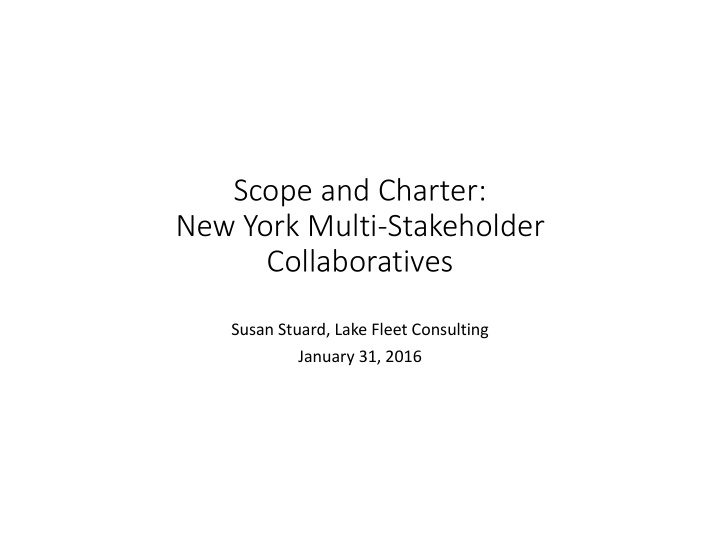



Scope and Charter: New York Multi ‐ Stakeholder Collaboratives Susan Stuard, Lake Fleet Consulting January 31, 2016
Background • My comments on role of scope and charter are informed by facilitation of the following multi ‐ stakeholder workgroups: • Hudson Valley Patient Centered Medical Home Project (2008 ‐ 2011) • CPC Classic: NY’s Capital ‐ Hudson Valley Region (2012 ‐ 2016) • CPC+: NY’s Capital ‐ North Hudson Region (2017 ‐ 2021) • NYS’s Advanced Primary Care Initiative, Capital ‐ Hudson Region (2017 ‐ ?)
Scope and Charter as a Tool • A workgroup’s development of scope and charter is more about process than outcome • Enable diverse group of stakeholders to come together, decide on their role(s), ground rules, and focus areas • It is an important first activity as it allows stakeholders to feel safe working together and enfranchised in the subsequent work of the group • Discussing hypothetical scenarios can help the group get ready to handle conflict later • Have found that a workgroup rarely returns to the scope and charter after development, but that does not diminish the importance of the activity
Questions to Consider • The following are some questions that it might be useful to consider when discussing and drafting a scope and charter 1. Group’s purpose 2. Group’s composition 3. Areas of deliberation 4. Decision ‐ making 5. Facilitation and convening 6. End point 7. Confidential information 8. External relations • Pick and choose: not all items will be relevant to your group or should be documented in the charter
Questions to Consider 1. Document purpose. Discuss both scope and purpose and develop a short description for charter. Some groups lump scope and purpose together; some prefer to separate. • What is the workgroup’s purpose? • What is the workgroup’s scope? 2. Document the group composition. • Who names members to the group? Are members named by the workgroup, the individual organizations, or a sponsoring entity? • How will the group decide if new members will be added? • What are the expectations of representatives for their participation within the group and to represent the group’s work within their own organization?
Questions to Consider 3. Decision ‐ making • Will the group make decisions by consensus or a vote? If a vote, what constitutes a majority and who are the voting members? Are there non ‐ voting members? • Is the workgroup advisory only meaning that its decisions are not binding? • Does the workgroup have any binding decision ‐ making authority? 4. Areas of deliberation • Sometimes it can be useful to define possible areas of deliberation for the group • This can be combined with scope and purposes in some instances; in others, it is useful to include areas of deliberation to provide more detail to the scope 5. Facilitation and convening • Who will be supporting the workgroup’s efforts by convening and facilitating its deliberations? • What are the high ‐ level expectations of how the convener/facilitator will support the workgroup?
Questions to Consider 6. End point. Is there a defined end point to the group’s work? • Include an end date if appropriate • Or considering defining how the group may elect to disband 7. Confidential information. How will the group handle confidential information? • What are the norms that the group will use to handle confidential information? • Will the group use Chatham House or Vegas rules for information shared in discussion? 8. External relations. Publicity, use of names, external presentations • Discuss how and when representatives can publicly share information about the group and its work? • Are there any approvals needed?
Recommend
More recommend